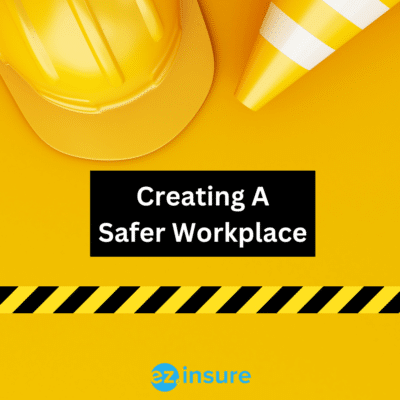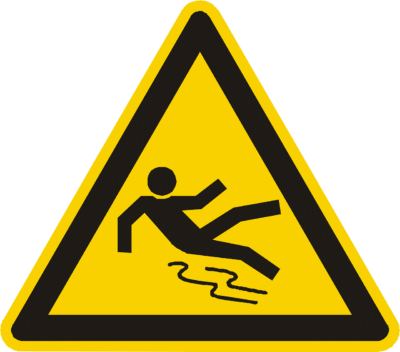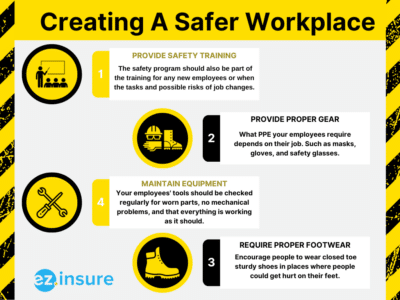
Jump To:
-
What is Workers’ Compensation Insurance?
-
How Workers’ Compensation Works
-
Benefits of Workers’ Compensation
-
Types of Workers’ Compensation
-
Who Is Covered by Workers’ Compensation Insurance?
-
The Cost of Workers’ Compensation
-
How to Save on Workers’ Compensation Insurance
-
FAQs
What is Workers’ Compensation Insurance?
Workers’ compensation insurance, also known as “workers’ comp,” is a legally required (all states except Texas) type of insurance policy that pays benefits to your employees in the event that they are injured on the job.
It functions as a disability insurance fund, providing monetary compensation, healthcare benefits, or both, to employees. Workers’ compensation guidelines vary by state, so check out our workers’ compensation state pages to find out how your state handles workers’ comp regulations.
How Workers’ Compensation Works
The majority of workers’ compensation policies are funded by premiums the insurance carrier collects from you as the business owner. When disagreements arise, the Workers’ Compensation Board, the state entity that manages the program, steps in to handle them.
There are different types of workers’ comp, depending on your industry, with some policies administered by the government in special cases. For example, government employees, longshore and harbor workers, and energy workers are all covered by federal workers’ compensation programs. And for coal miners and their families, the Black Lung Program administers death and disability benefits.
Benefits of Workers’ Compensation
Workers’ compensation benefits may include a portion of lost wages for the time your employee was unable to work. Reimbursement for medical services and occupational therapy may also be paid to your injured employee.
Salary Replacement
In most cases, a workers’ compensation applicant will get some replacement for their lost wages. But it will usually be less than their full pay. The majority of policies cover roughly two-thirds of the beneficiary’s gross pay. Although the payout is often not taxable at the state or federal levels, recipients who receive money from the Supplemental Security Income or Social Security Disability programs may have to pay taxes on those benefits.
Medical Expenses
Workers’ compensation insurance also offers coverage for medical costs associated with an illness or accidents sustained at work. This may include trips to the hospital, surgeries, and medication. In the case of workplace-related illnesses or injuries that are so serious that they require multiple treatments, workers’ comp will cover ongoing care. It will also cover repetitive injuries that manifest over time.
It’s important to note that the majority of workers’ compensation policies only cover medical costs for injuries sustained directly as a result of working. A construction worker, for instance, could seek reimbursement for injuries sustained in a fall from scaffolding, but not for those sustained while traveling to the job site.
Disability Coverage
Some workplace accidents could be severe enough to render your employee permanently or temporarily disabled. In this case, your disabled employee may be eligible for benefits under your workers’ compensation policy to assist with paying their medical expenses and to partially make up for lost wages.
Survivor Benefits
Workers’ compensation can help pay for funeral costs, as well as pay survivor benefits to your employee’s dependents if your employee passes away as a result of a work-related incident.
Types of Workers’ Compensation
Each state is responsible for enforcing workers’ comp laws. There are no federal standards for this type of insurance, so depending on your location, the same injuries may result in radically different types of compensation.
But, when it comes to policy types, there are two types of workers’ compensation policies you can buy for your staff:
- Coverage A – This type of policy includes all of the basic state-mandated benefits that an injured or ill employee is entitled to. In addition to salary replacement payments, it also includes any necessary medical treatment, rehabilitation, and death benefits. These benefits are available in every state, with the exception of Texas. Although the payouts vary greatly from state-to-state and are not always available to all employees.
- Coverage B – This type of policy provides benefits over the basic minimum required, as offered by Coverage A. With coverage B though, employees are typically only compensated following the employee’s successful lawsuit alleging negligence or other wrongdoing.
In most states employees forfeit their right to hold their employer accountable for negligence by agreeing to receive workers’ compensation. The goal of this wage agreement is to safeguard both employees and employers. In exchange for assurance of payment, workers forgo additional recourse, and employers accept some liability in order to avoid the possibly higher costs of a negligence action.
Even though employees who receive workers’ compensation typically consent to a “no-fault” contract by giving up their right to sue their employers, state legislation and court decisions in certain jurisdictions have restored employees’ abilities to file lawsuits in a number of strictly limited situations. So, depending on where your business is located, you may decide to buy insurance that combines Coverage A and Coverage B.
Who Is Covered by Workers’ Compensation Insurance?
Who must be covered by workers’ compensation insurance depends on a number of factors—the size of your company, and the types of employees you have. For example, in some states, a company must have a certain minimum number of workers before it is required to have workers’ compensation insurance. And, while regulations vary by state, in the majority of states, all full-time employees are required to be covered by workers’ compensation insurance. Workers’ compensation regulations for independent contractors, temporary employees, and interns vary by state.
The industry you work in also makes a difference. For example, in certain states, coverage for workers’ compensation is not necessary for:
- Farmhands
- Insurance agents
- Family members under a certain age
- Casual workers
- Business owners and partners
- Real estate agents
Additionally, employees of the federal government are not protected by state-mandated workers’ compensation insurance. They are instead covered by federal workers’ compensation.
You should be familiar with the workers’ compensation regulations in your state, because these exceptions do not apply in every state.
The Cost of Workers’ Compensation
Workers’ comp insurance premiums are generally set based on every $100 of your company’s payroll. Even so, it’s difficult to pinpoint an exact price without evaluating the different factors for your specific company. On average you can expect to pay anywhere from $0.60 to $2.27 per every $100 on your payroll.
To understand how the cost of your workers’ compensation insurance will be determined, you need to understand a few basic components of the equation:
Payroll
Every workers’ compensation insurance rate is calculated by dividing your payroll by $100. That means the more employees you have, the higher your rate will be. It’s important to keep in mind, though, that you’ll need coverage in some states as soon as you have a single employee, while in others you won’t need it unless you have three or more employees.
Depending on the regulations of your state, you might have employees who do not have to have coverage. For instance, you are probably not required to obtain workers’ compensation for yourself as the business owner. The same often holds true for company executives and limited liability company (LLC) members.
Workers’ Compensation Industry Classification
Certain industries pose higher risks than others. For example, someone working on oil rigs have a substantially higher risk of serious injury than an office worker. Workers in some professions, including contracting and building, run an increased risk. Which drives up the cost of insurance for those people.
States provide a class code for each type of industry. And each code is then given a base rate based on its risk for injury. 38 states employ class codes that were created by the NCCI. Others make use of independent rating agencies, while some have developed their own systems.
Employee Modification Rate
The EMR is a multiplier that represents the history of your claims. Your state workers’ compensation board or its ratings bureau compares your prior workers’ compensation claims to those of businesses in your industry to determine your EMR. Businesses with lower EMRs often pay less for their workers’ compensation insurance, with the typical range of EMRs being 0.75 to 1.25.
State Insurance Factors
Workers’ compensation insurance premiums vary from state-to-state because state laws regulate coverage. The cost of workers’ compensation will most certainly be higher in a state that provides higher or more payments to injured workers, or in a state with a lot of high-risk industries.
Several states though, give employers discounts if they take steps to increase safety and decrease claims. For instance, many state governments offer discounts for setting up safety committees, fall prevention programs, and drug-free workplaces.
Insurance Carriers
While most of the above factors are out of your control, you can still find the best price for your business by shopping around among different insurance carriers. Although this isn’t a universal rule, some workers’ compensation insurance carriers charge higher premiums than others.
The Calculations
The basic formula for estimating workers’ compensation costs takes into account your industry, past claims, and total payroll. The basic formula is your annual employee payroll divided by 100. That sum is then multiplied by the workers comp insurance rate. That total is the estimated cost of your workers compensation premiums.
There are many moving parts in the precise formulas that insurers use to compute your workers’ compensation premium, and the methods they use to do so can differ from one insurer to another. Additionally, these formulas are based on your state-specific workers’ compensation regulations.
You should also take into account that there will be an option to pay your premium annually or monthly. This decision can also affect your price.
You should also consider any adjustments that might be made to your payroll during the year, including changes in your number of employees, your business class code, and your workers’ compensation rate, in order to choose the appropriate payment method for your company.
How to Save on Workers’ Compensation Insurance
The best way to make sure you can get affordable workers’ compensation insurance rates is to reduce the number and cost of your workers’ compensation claims.
You won’t have many options for cost-cutting when an employee submits a claim. To avoid having to pay large premiums in the future, you must put your plans in place as soon as possible.
You should think about implementing the following steps, which could be beneficial to both your company and your employees:
Return to Work Programs
Return to work programs help you get your employees back to work as soon as they are healthy enough.
A return-to-work program might help an employee ease back into their old responsibilities gradually, rather than having to wait until they’re fully recover to handle them. Until they are able to return to their regular tasks, the employee may perform light or modified work.
As part of this program, your employee can receive new training in a different skill set in order to earn their regular pay, instead of the lower rate provided as part of their workers’ compensation claim.
The advantage of this program is that you save money on wages given to any temporary workers you would have had to recruit to cover for your injured employee while they were recovering.
Work Safety Initiatives
The easiest way to reduce the price of workers’ compensation insurance is to avoid work-related illnesses and injuries as much as possible.
To motivate your employees to maintain a safe workplace and lower injury risks, be proactive about encouraging workplace safety measures. Here are some actions you can take to encourage a safer workplace:
- Conduct regular safety training – Reaffirm best practices for conduct and safety, and keep on top of employee training for things like equipment usage.
- Create a welcoming environment with an open door policy – It should be easy for your employees to approach you with questions about their safety. Remind them to visit you if they want to discuss workplace safety. Pay attention to their concerns, then take appropriate steps to reduce the risks and guarantee the safety of your staff.
- Be open and honest about workers’ compensation benefits – When you hire new employees, you should tell them about your company’s policies on workers’ compensation. To remind current employees how workers’ compensation works if they are hurt on the job, arrange an employee benefits refresher.
Your team will feel more at ease and valued if you communicate openly and honestly about the policies you have in place to safeguard and promote their safety.
FAQs
-
Who pays workers’ compensation premiums?
By law, you as the employer pay the workers’ compensation premium. You can not deduct workers’ compensation payments through your employee’s paycheck.
-
Who is exempt from workers’ compensation?
Most of the time, only your employees can get workers’ compensation. Contractors or freelancers are almost never included in your plan. Aside from that each state makes its own laws. Arkansas, for example, does not require farm workers or real estate agents to have workers’ compensation.
-
How many employees do I need to get workers’ compensation insurance?
Every state has different requirements for workers’ compensation. Some states have you get coverage with even 1 employee while others require 3 or more.
Get Workers’ Compensation Coverage with EZ.Insure!
Workers’ compensation insurance exists to safeguard both your company and your employees. At EZ.Insure our experienced representatives are here to answer any additional questions you may have about the specifics of workers’ compensation in your state or industry.
To get a free, no-obligation quote simply enter your ZIP code below or give us a call at (855)-694-0047.





